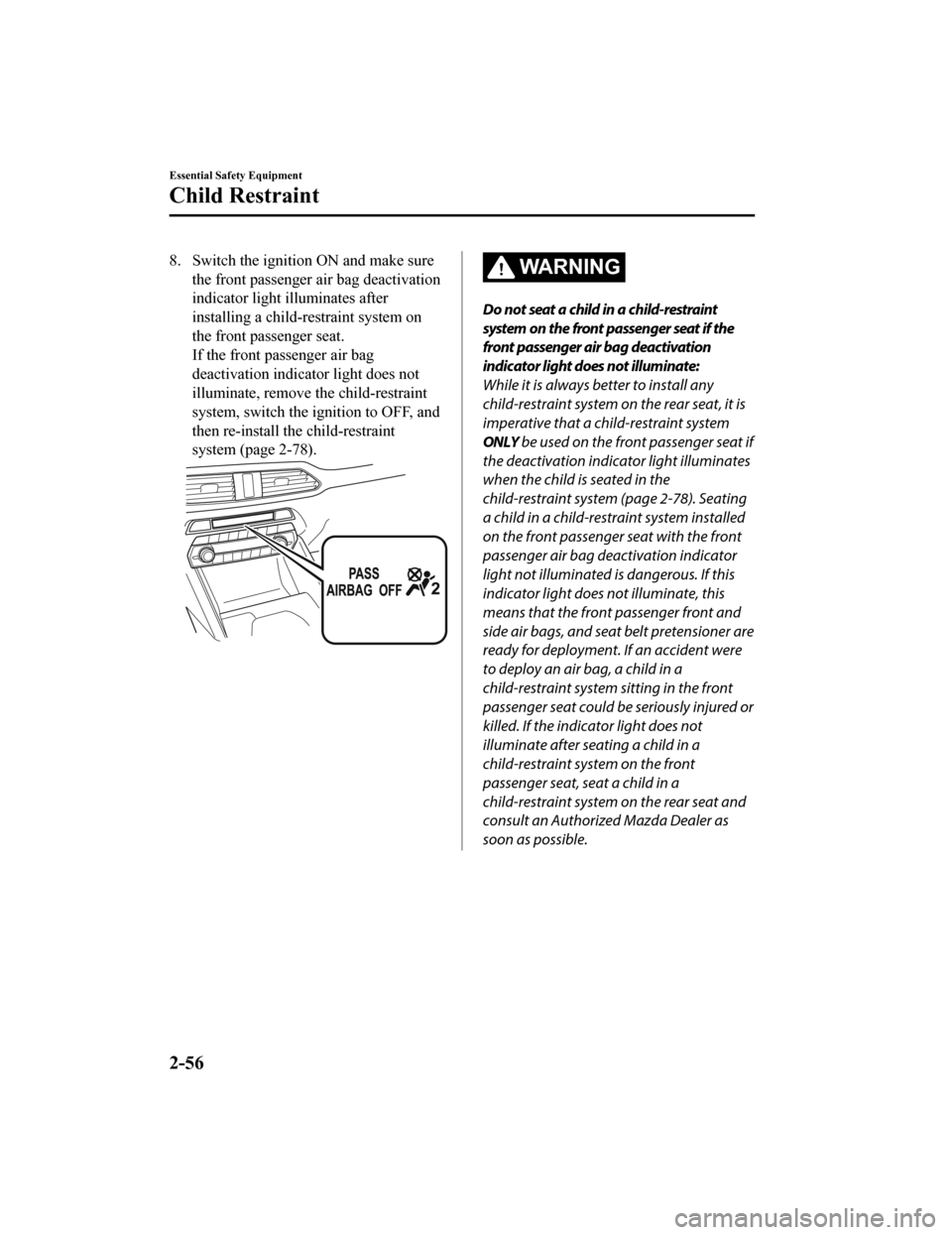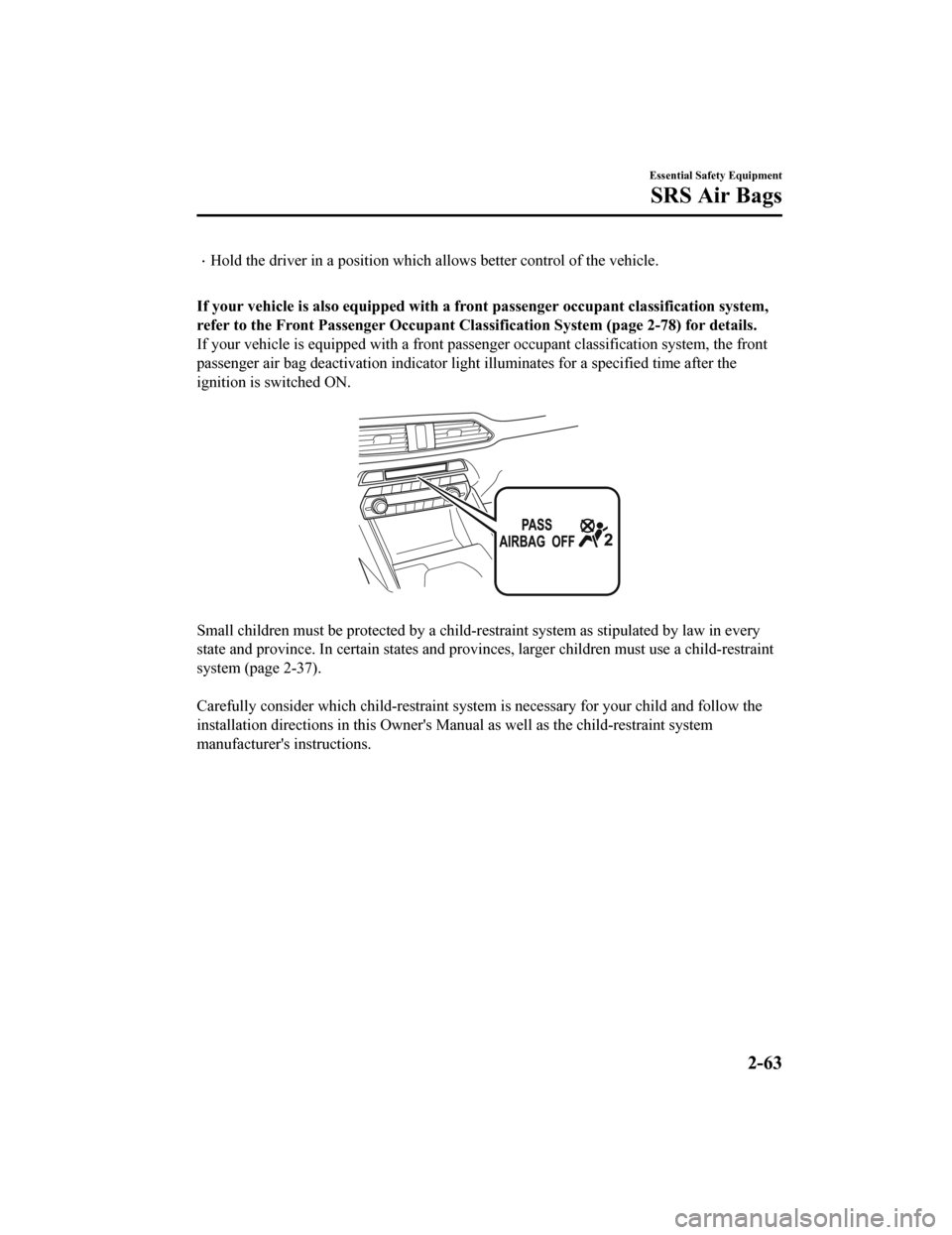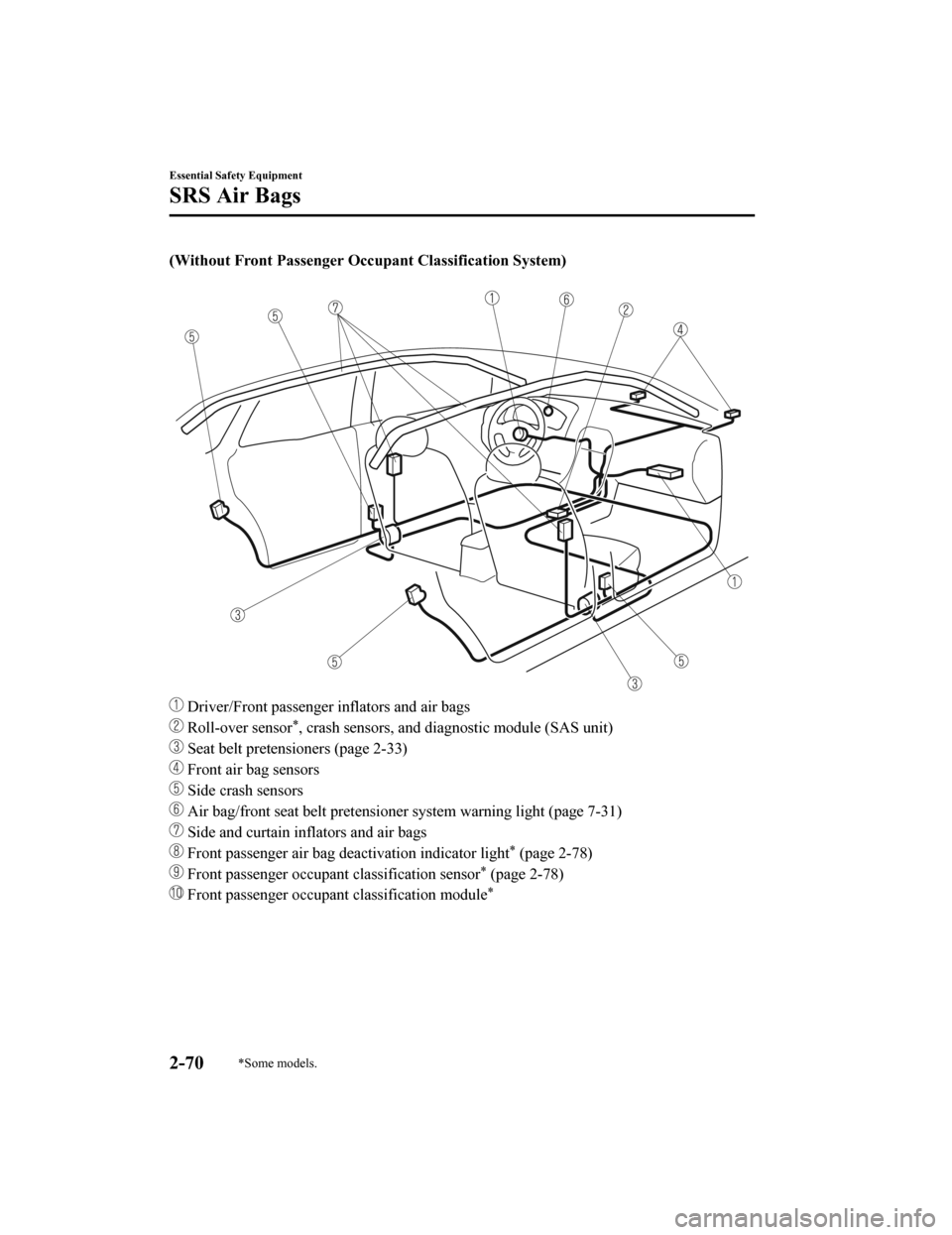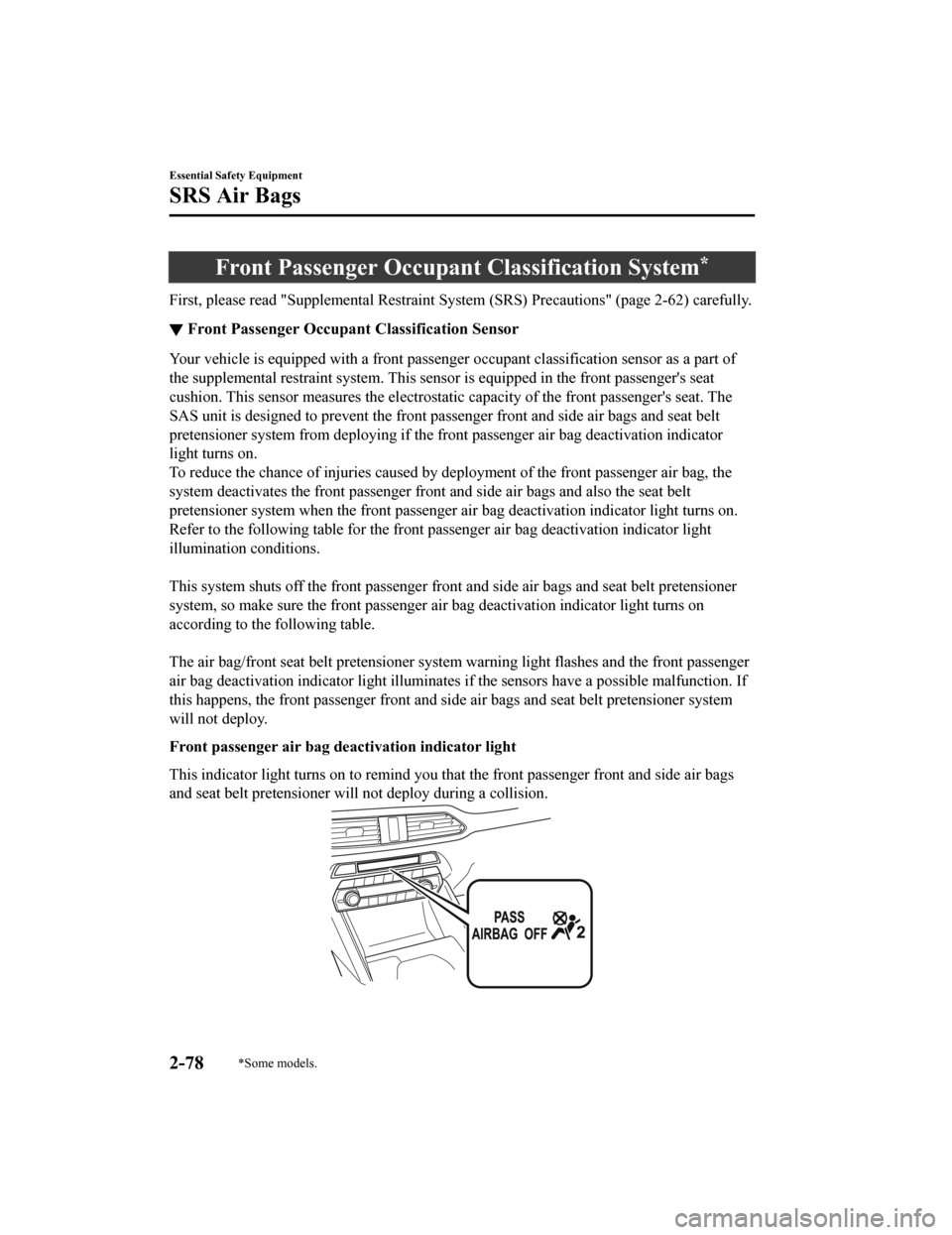light MAZDA MODEL CX-9 2019 (in English) Owner's Manual
[x] Cancel search | Manufacturer: MAZDA, Model Year: 2019, Model line: MODEL CX-9, Model: MAZDA MODEL CX-9 2019Pages: 692
Page 56 of 692

Child-Restraint System Suitability for Various SeatPositions Table
(Mexico)
Provided information in the table shows your child-restraint sy stem suitability for various
seating position. For installati on suitability of other manufacturer child-restraint system,
carefully consult the manufacturer's instructions which accompa ny the child-restraint
system.
When installing a child-restrain t system, the following points must be observed:
’éĘ(Front passenger seat/Second-row seat)
Always remove the head restraint before installing a child-rest raint system. However,
when installing a backless booster seat, always install the veh icle head restraint to the seat
where the backless booster seat is installed. In addition, alwa ys use a tether strap and
attach it securely. Refer to Head Restraints on page 2-21.
’éĘWhen installing a child-restrain t system to the front passenger seat, adjust the seat slide
position as far back as possible. Adjust the seat bottom (height adjustable seat bottom) to
the highest position so that the seat belt can securely fasten the child-restraint system.
Refer to Adjusting the Front Passenger's Seat on page 2-13.
’éĘWhen it is diffi cult to install a child-restraint system to the front passenger seat/
second-row seat, or the seat belt cannot be secured to the chil d-restraint system, perform
the following operations to adju st the seat holding the child-restraint system so that the
seat belt can be secured completely to it.
’éĘMove the seat forward.
’éĘMove the seatback forward or back.
(Second-row seat)
’éĘWhen installing a child-restrain t system came equipped with a t ether, remove the head
restraint.
Refer to Head Restraints on page 2-21.
’éĘWhen installing a child-restrain t system using the ISOFIX lower anchors, if the
connectors of the child-restrain t system do not reach the lower anchorage and the
child-restraint system cannot be installed, slightly tilt the seatback of the seat holding the
child-restraint system rearward. If the seatback of a second-row seat cannot be reclined
due to interference with luggage on the rear seat or passengers, slide the seat forward once
and then recline the seatback.
Essential Safety Equipment
Child Restraint
2-44
CX-9_8HB2-EA-18G_Edition1 2018-5-11 13:09:27
Page 66 of 692

WA R N I N G
Always move the front passenger seat as
far back as possible if installing a
front-facing child-restraint system on it is
unavoidable:
As your vehicle has front air bags and
doubly so because your vehicle has side air
bags, a front-facing child-restraint system
should be put on the front passenger seat
only when it is unavoidable.
Even if the front passenger air bag
deactivation indicator light illuminates,
always move the seat as far back as
possible, because the force of a deploying
air bag could cause serious injury or death
to the child.
Never use a rear-facing child-restraint
system in the front seat with an air bag
that could deploy:
Rear-facing child-restraint systems on the
front seat are particularly dangerous.
Even in a moderate collision, the
child-restraint system can be hit by a
deploying air bag and moved violently
backward resulting in serious injury or
death to the child. Even though you may
feel assured that the front passenger air
bag will not deploy based on the fact that
the front passenger air bag deactivation
indicator light illuminates, you should not
use a rear-facing child-restraint system in
the front seat.
Do not allow a child or anyone to lean over
or against the side window of a vehicle
with side and curtain air bags:
It is dangerous to allow anyone to lean
over or against the side window, the area
of the front passenger seat, the front and
rear window pillars and the roof edge
along both sides from which the side and
curtain air bags deploy, even if a
child-restraint system is used. The impact
of inflation from a side or curtain air bag
could cause serious injury or death to an
out of position child. Furthermore, leaning
over or against the front door could block
the side and curtain air bags and eliminate
the advantages of supplemental
protection. With the front air bag and the
additional side air bag that comes out of
the front seat, the rear seat is always a
better location for children. Take special
care not to allow a child to lean over or
against the side window, even if the child is
seated in a child-restraint system.
Always remove the head restraint and
install child-restraint system (except when
installing a backless booster seat):
Installing a child-restraint system without
removing the head restraint is dangerous.
The child-restraint system cannot be
installed correctly which may result in
death or injury to the child in a collision.
Always install the head restraint and adjust
it to the appropriate position after
removing the child-restraint system:
Driving with the head restraint removed is
dangerous as impact to the occupant's
head cannot be prevented during
emergency braking or in a collision, which
could result in a serious accident, injury or
death.
Essential Safety Equipment
Child Restraint
2-54
CX-9_8HB2-EA-18G_Edition12018-5-11 13:09:27
Page 68 of 692

8. Switch the ignition ON and make surethe front passenger air bag deactivation
indicator light illuminates after
installing a child-restraint system on
the front passenger seat.
If the front passenger air bag
deactivation indicator light does not
illuminate, remove the child-restraint
system, switch the i gnition to OFF, and
then re-install the child-restraint
system (page 2-78).WA R N I N G
Do not seat a child in a child-restraint
system on the front passenger seat if the
front passenger air bag deactivation
indicator light does not illuminate:
While it is always better to install any
child-restraint system on the rear seat, it is
imperative that a child-restraint system
ONLY be used on the front passenger seat if
the deactivation indicator light illuminates
when the child is seated in the
child-restraint system (page 2-78). Seating
a child in a child-restraint system installed
on the front passenger seat with the front
passenger air bag deactivation indicator
light not illuminated is dangerous. If this
indicator light does not illuminate, this
means that the front passenger front and
side air bags, and seat belt pretensioner are
ready for deployment. If an accident were
to deploy an air bag, a child in a
child-restraint system sitting in the front
passenger seat could be seriously injured or
killed. If the indicator light does not
illuminate after seating a child in a
child-restraint system on the front
passenger seat, seat a child in a
child-restraint system on the rear seat and
consult an Authorized Mazda Dealer as
soon as possible.
Essential Safety Equipment
Child Restraint
2-56
CX-9_8HB2-EA-18G_Edition1 2018-5-11 13:09:27
Page 70 of 692

Make sure there are no seat belts or foreign objects near or around the ISOFIX/LATCH*1
child-restraint system:
Not following the child-restraint system manufacturer's instructions when installing the
child-restraint system is dangerous. If seat belts or a foreign object prevent the child-restraint
system from being securely attached to the ISOFIX/LATCH
*1 lower anchors and the
child-restraint system is installed improperly, the child-restraint system could move in a
sudden stop or collision causing serious injury or death to the child or other occupants. When
installing the child-restraint system, make sure there are no seat belts or foreign objects near
or around the ISOFIX/LATCH
*1 lower anchors. Always follow the child-restraint system
manufacturer's instructions.
*1 ISOFIX (Mexico)/LATCH (Except Mexico)
Installation on second-row outboard
seats
1. First, adjust the front seat to allow clearance between the child-restraint
system and the front seat.
Refer to Adjusting the Driver's Seat on
page 2-5.
Refer to Adjusting the Front
Passenger's Seat on page 2-13.
2. Adjust the second-row seat position using the following procedure.
Fold the second-row seatback
forward.
Raise the second-row seatback until
a click sound is heard and it is locked
in place.
3. If the second-row seat is reclined, return it to the u pright position.
4. Make sure the seatback is securely
latched by pushing it back until it is
fully locked.
5. Expand the area between the seat
bottom and the seatback slightly to
verify the locatio ns of the ISOFIX/
LATCH
*1 lower anchors.
NOTE
’éĘThe markings above the ISOFIX/
LATCH
*1 lower anchors indicate the
locations of the ISOFIX/LATCH
*1
lower anchors for the attachment of
a child-restraint system.
Essential Safety Equipment
Child Restraint
2-58
CX-9_8HB2-EA-18G_Edition1 2018-5-11 13:09:27
Page 75 of 692

’éĘHold the driver in a position which allows better control of the vehicle.
If your vehicle is also equipped with a front passenger occupant classification system,
refer to the Front Pas senger Occupant Classi fication System (page 2-78) for details.
If your vehicle is equipped with a front passenger occupant classification system, the front
passenger air bag deactivation i ndicator light illuminates for a specified time after the
ignition is switched ON.
Small children mu st be protected by a child-restraint system as stipulated by law in every
state and province. In certain s tates and provinces, larger children must use a child-restraint
system (page 2-37).
Carefully consider which child-restraint system is necessary fo r your child and follow the
installation directions in this Owner's Manual as well as the c hild-restraint system
manufacturer's instructions.
Essential Safety Equipment
SRS Air Bags
2-63
CX-9_8HB2-EA-18G_Edition1 2018-5-11 13:09:27
Page 76 of 692

WA R N I N G
Seat belts must be worn in air bag equipped vehicles:
Depending only on the air bags for protection during an accident is dangerous. Alone, air
bags may not prevent serious injuries. The appropriate air bags can be expected to
inflate
only in the first accident, such as frontal, near frontal or side collision s or roll-over accidents
that are at least moderate. Vehicle occu pants should always wear seat belts.
Children should not ride in the front passenger seat:
Placing a child, 12 years or under, in the front seat is dangerous. The child could be hit by a
deploying air bag and be seriously injured or even killed. A sleeping child is more likely to lean
against the door and be hit by the side air ba g in moderate collision to the front-passenger
side of the vehicle. Whenever possible, always secure a child 12 years and under on the rear
seats with an appropriate child-restrain t system for the child's age and size.
Never use a rear-facing child-restraint system in the front seat with an air bag that could
deploy:
Rear-facing child-restraint systems on the front seat are particularly dangerous even though
you may feel assured that a front passenger air ba g will not deploy based on the fact that the
front passenger air bag deactivation indicator light illuminates. The child-restraint system
can be hit by a deploying air bag and moved viol ently backward resulting in serious injury or
death to the child.
Do not sit too close to the driver and front passenger air bags:
Sitting too close to the driver and front passenger air bag modules or placing hands or feet on
them is extremely dangerous. The driver and fron t passenger air bags inflate with great force
and speed. Serious injuries could occur if some one is too close. The driver should always hold
onto only the rim of the steering wheel. The front seat passenger should keep both feet on the
floor. Front seat occupants should adjust their seats as far back as possible and always sit
upright against the seatbacks wi th seat belts worn properly.
Essential Safety Equipment
SRS Air Bags
2-64
CX-9_8HB2-EA-18G_Edition1 2018-5-11 13:09:27
Page 80 of 692

NOTE
’éĘIf it becomes necessary to have the components or wiring system for the supplementary
restraint system modified to accommodate a person with certain medical conditions in
accordance with a certified physician, contact an Authorized Mazda Dealer, refer to
ŌĆ£Customer Assistance (U.S.A.)ŌĆØ (page 8-2).
’éĘWhen an air bag deploys, a loud inflation noise can be heard and some smoke will be
released. Neither is likely to cause injury, however, the text ure of the air bags may cause
light skin injuries on body parts not covered with clothing through friction.
’éĘShould you sell your Mazda, we urge you to tell the new owner of its air bag systems and
that familiarization with all instructions about them, from the Owner's Manual, is
important.
’éĘThis highly-visible label is displayed wh ich warns against the use of a rear-facing
child-restraint system on the front passenger seat.
(Except Mexico) (Mexico)
Essential Safety Equipment
SRS Air Bags
2-68
CX-9_8HB2-EA-18G_Edition1 2018-5-11 13:09:27
Page 82 of 692

(Without Front Passenger Occupant Classification System)
Driver/Front passenger inflators and air bags
Roll-over sensor*, crash sensors, and diagnostic module (SAS unit)
Seat belt pretensioners (page 2-33)
Front air bag sensors
Side crash sensors
Air bag/front seat belt pretensi oner system warning light (page 7-31)
Side and curtain inflators and air bags
Front passenger air bag deactivation indicator light* (page 2-78)
Front passenger occupant classification sensor* (page 2-78)
Front passenger occupant classification module*
Essential Safety Equipment
SRS Air Bags
2-70*Some models.
CX-9_8HB2-EA-18G_Edition1 2018-5-11 13:09:27
Page 86 of 692

Ō¢╝Warning Light/Beep
A system malfunction or operation conditions are indicated by a
warning.
Refer to Contact Authorized Mazda Dealer and Have Vehicle Inspected on page 7-31.
Refer to Warning Sound is Activated on page 7-46.
Essential Safety Equipment
SRS Air Bags
2-74
CX-9_8HB2-EA-18G_Edition1 2018-5-11 13:09:27
Page 90 of 692

Front Passenger Occupant Classification System*
First, please read "Supplemental Restraint System (SRS) Precaut ions" (page 2-62) carefully.
Ō¢╝Front Passenger Occupant Classification Sensor
Your vehicle is equipped with a front passenger occupant classi
fication sensor as a part of
the supplemental restraint system. This sensor is equipped in the front passenger's seat
cushion. This sensor measures the electrostatic capacity of the front passenger's seat. The
SAS unit is designed to prevent the front passenger front and side air bags and seat belt
pretensioner system from deploying if the front passenger air b ag deactivation indicator
light turns on.
To reduce the chance of injuries caused by deployment of the fr ont passenger air bag, the
system deactivates the front passenger front and side air bags and also the seat belt
pretensioner system when the front passenger air bag deactivati on indicator light turns on.
Refer to the following table fo r the front passenger air bag de activation indicator light
illumination conditions.
This system shuts off the front passenger front and side air bags and seat belt pretensioner
system, so make sure the front passenger air bag deactivation i ndicator light turns on
according to the following table.
The air bag/front seat belt pretensioner system warning light f lashes and the front passenger
air bag deactivation indicator li ght illuminates if the sensors have a possible malfunction. If
this happens, the front passenger front and side air bags and s eat belt pretensioner system
will not deploy.
Front passenger air bag de activation indicator light
This indicator light turns on to remind you that the front pass enger front and side air bags
and seat belt pretensioner wil l not deploy during a collision.
Essential Safety Equipment
SRS Air Bags
2-78*Some models.
CX-9_8HB2-EA-18G_Edition1 2018-5-11 13:09:27